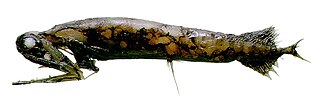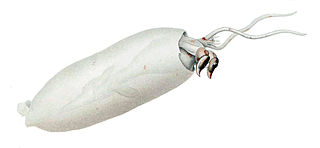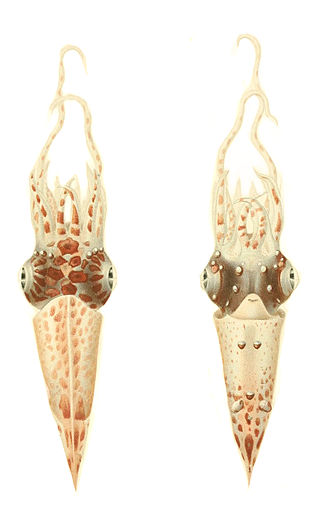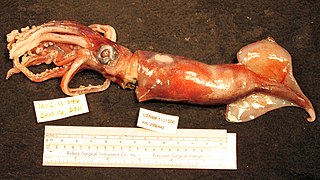
A squid is a mollusc with an elongated soft body, large eyes, eight arms, and two tentacles in the superorder Decapodiformes, though many other molluscs within the broader Neocoleoidea are also called squid despite not strictly fitting these criteria. Like all other cephalopods, squid have a distinct head, bilateral symmetry, and a mantle. They are mainly soft-bodied, like octopuses, but have a small internal skeleton in the form of a rod-like gladius or pen, made of chitin.

Histioteuthis is a genus of squid in the family Histioteuthidae. It goes by the common name cock-eyed squid, because in all species the right eye is normal-sized, round, blue and sunken; whereas the left eye is at least twice the diameter of the right eye, tubular, yellow-green, faces upward, and bulges out of the head.

Malacosteus niger, commonly known as the black dragon fish, is a species of deep-sea fish. Some additional common names for this species include: northern stoplight loosejaw, lightless loosejaw, black loosejaw, and black hinged-head. It belongs to the family Stomiidae, or dragonfishes. It is among the top predators of the open mesopelagic zone. M. niger is a circumglobal species, which means that it inhabits waters ranging from the tropics to the subarctics. Not many studies have been conducted on its feeding habits, but recent research suggests that M. niger primarily feed on calanoid copepods which is a form of zooplankton. Indeed, it appears that M. niger primarily prey on zooplankton despite its apparent morphological adaptations for the consumption of relatively large prey. Another unique adaptation for this species is its ability to produce both red and blue bioluminescence. Most mesopelagic species aren't capable of producing red bioluminescence. This is advantageous because most other species cannot perceive red light, therefore allowing M. niger to camouflage part of itself to its prey and predators.

The firefly squid, also commonly known as the sparkling enope squid or hotaru-ika in Japan, is a species of squid in the family Enoploteuthidae. W. scintillans is the sole species in the monotypic genus Watasenia.

Sandalops melancholicus, the sandal-eyed squid or melancholy cranch squid, is a small species of glass squid. It is known to reach a mantle length of 11 cm (4.3 in). It is distributed in the tropical and subtropical oceans around the world. It is the only species in the genus Sandalops but some authorities suggest that this may be a species complex rather than a monotypic genus.

Helicocranchia pfefferi, the banded piglet squid, is a small squid of the genus Helicocranchia. Adults of this species are mesopelaegic.

Onychoteuthis banksii, the common clubhook squid, is a species of squid in the family Onychoteuthidae. It is the type species of the genus Onychoteuthis. This species was thought to have a worldwide distribution but with the revision of the genus Onychoteuthis in 2010, it is now accepted that Onychoteuthis banksii is restricted to the central and northern Atlantic and the Gulf of Mexico while a recently described species, Onychoteuthis horstkottei, is found in the Pacific Ocean. The type locality is the Gulf of Guinea.

Histioteuthis bonnellii, the umbrella squid, is a species of cock-eyed squid belonging to the family Histioteuthidae.

Histioteuthis reversa, commonly known as the reverse jewel squid or the elongate jewel squid, is a species of cock-eyed squid, so called because the eyes are dissimilar. It occurs at moderate depths in the Atlantic Ocean and the Mediterranean Sea. It is also known from the Indian Ocean.
Stigmatoteuthis arcturi, commonly known as the jewelled squid, is a species of cock-eyed squid from the family Histioteuthidae. It occurs throughout the subtropical and tropical Atlantic Ocean in the mesopelagic zone.

Pterygioteuthis giardi is a species of squid in the family Pyroteuthidae. It is known as the roundear enope squid. The specific name honors the French zoologist and marine biologist Alfred Mathieu Giard (1846-1908).

The colossal squid is the largest member of its family Cranchiidae, the cockatoo or glass squids, with its second largest member being Megalocranchia fisheri. It is sometimes called the Antarctic cranch squid or giant squid and is believed to be the largest squid species in terms of mass. It is the only recognized member of the genus Mesonychoteuthis and is known from only a small number of specimens. The species is confirmed to reach a mass of at least 495 kilograms (1,091 lb), though the largest specimens—known only from beaks found in sperm whale stomachs—may perhaps weigh as much as 600–700 kilograms (1,300–1,500 lb), making it the largest known invertebrate. Maximum total length has been estimated at 9–10 metres (30–33 ft). The colossal squid has the largest eyes of any known creature ever to exist, with an estimated diameter of 27 cm (11 in).
Teuthowenia pellucida, the googly-eyed glass squid, is a rare deep-sea glass squid whose habitat ranges throughout the oceans of the Southern Hemisphere.

Counter-illumination is a method of active camouflage seen in marine animals such as firefly squid and midshipman fish, and in military prototypes, producing light to match their backgrounds in both brightness and wavelength.

Abralia veranyi is a species of squid in the family Enoploteuthidae. Common names include the eye-flash squid, Verany's enope squid and the midwater squid. It is found in the Atlantic Ocean and the Mediterranean Sea. It undergoes a daily vertical migration from deep waters to near the surface.
Lampadioteuthis megaleia is a small, colorful squid, the only species in the only genus in the monotypic family Lampadioteuthidae. It is sometimes known as the wonderful firefly squid. It was formerly classified in the family Lycoteuthidae, but differs from them mainly by having a hectocotylus in the males and by the possession of a rostrum on the gladius.

Ornithoteuthis antillarum, the Atlantic bird squid, is a species of flying squid from the family Ommastrephidae which is found in the warmer waters of the Atlantic Ocean. This species is an important component of the diet of many species of fish and of cetaceans. It is taken as a bycatch in fisheries but has the potential to be commercially important if appropriate fishing methods can be developed.

Neoscopelus macrolepidotus, also known as a large-scaled lantern fish, is a species of small mesopelagic or bathypelagic fish of the family Neoscopelidae, which contains six species total along three genera. The family Neoscopelidae is one of the two families of the order Myctophiformes. Neoscopelidae can be classified by the presence of an adipose fin. The presence of photophores, or light-producing organs, further classify the species into the genus Neoscopelus. N. macrolepidotus tends to be mesopelagic until the individuals become large adults, which is when they settle down to the bathypelagic zone.
A micronekton is a group of organisms of 2 to 20 cm in size which are able to swim independently of ocean currents. The word 'nekton' is derived from the Greek νήκτον, translit. nekton, meaning "to swim", and was coined by Ernst Haeckel in 1890.
Histioteuthis meleagroteuthis is a species of small to medium squids that have a dark, wine-red skin pigment. Females at maturity average at 114 mm (4.5 in) in length, while males at maturity average at 65 to 102 mm in length. This species is characterized by tubercles, photophores, and asymmetric features. This species can be found in circumglobal, mesopelagic waters.
















